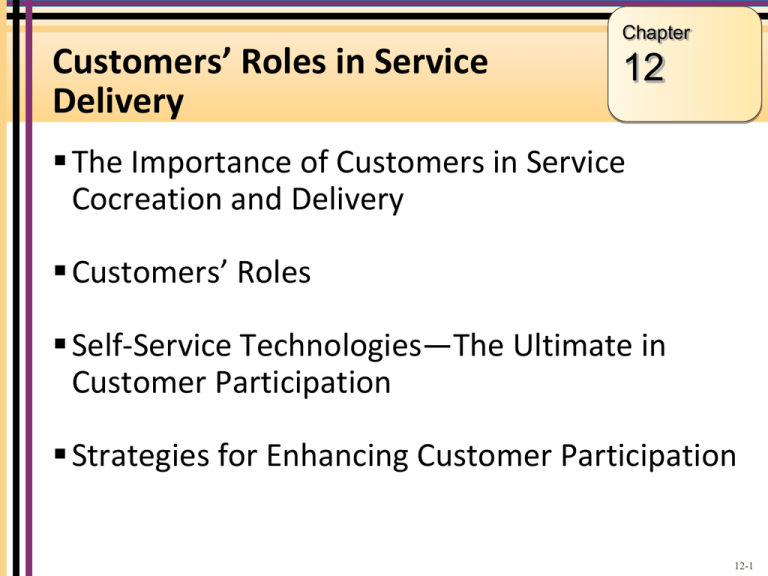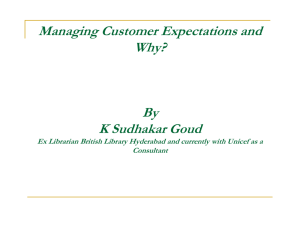Chapter 12
advertisement

Chapter Customers’ Roles in Service Delivery 12 The Importance of Customers in Service Cocreation and Delivery Customers’ Roles Self-Service Technologies—The Ultimate in Customer Participation Strategies for Enhancing Customer Participation 12-1 How Customers Widen the Service Performance Gap Lack of understanding of their roles Not being willing or able to perform their roles No rewards for “good performance” Interfering with other customers Incompatible market segments 12-2 Customer Participation across Different Services 12-3 Importance of Other (“Fellow”) Customers in Service Delivery Other customers can detract from satisfaction: Disruptive behaviors Overly demanding behaviors Excessive crowding Incompatible needs Other customers can enhance satisfaction: Mere presence Socialization/friendships Roles: assistants, teachers, supporters, mentors 12-5 Customer Roles in Service Delivery Productive Resources Contributors to Service Quality and Satisfaction Competitors 12-6 Customers as Productive Resources Customers can be thought of as “partial employees” Contributing effort, time, or other resources to the production process Customer inputs can affect organization’s productivity Key issue: Should customers’ roles be expanded? reduced? 12-7 Customers as Contributors to Service Quality and Satisfaction Customers can contribute to: Their own satisfaction with the service By performing their role effectively By working with the service provider The quality of the service they receive By asking questions By taking responsibility for their own satisfaction By complaining when there is a service failure 12-8 Customers as Competitors Customers may “compete” with the service provider “Internal exchange” vs. “external exchange” Internal/external decision often based on: Expertise capacity Resource capacity Time capacity Economic rewards Psychic rewards Trust Control 12-9 A Proliferation of Self-Service Technologies ATMs Pay at the pump Airline check-in Hotel check-in, out Automated car rental Blood pressure machines Tax prep software Self-checkout Online banking Online vehicle registration Online auctions Home and car buying online Package tracking Internet shopping IVR phone systems Distance education 12-10 Service Production Continuum 12-11 Strategies for Enhancing Customer Participation 12-12 Strategies for Enhancing Customer Participation Define customers’ roles Helping oneself Helping others Promoting the company Recruit, educate, and reward customers Recruit the right customers Educate and train customers to perform effectively Reward customers for their contributions Avoid negative outcomes of inappropriate customer participation Manage the customer mix 12-13 Compatibility Management “a process of first attracting homogeneous consumers to the service environment, then actively managing both the physical environment and customer-to-customer encounters in such a way as to enhance satisfying encounters and minimize dissatisfying encounters” (Martin and Pranter 1989) 12-14 Characteristics of Service that Increase the Importance of Compatible Segments 12-15











